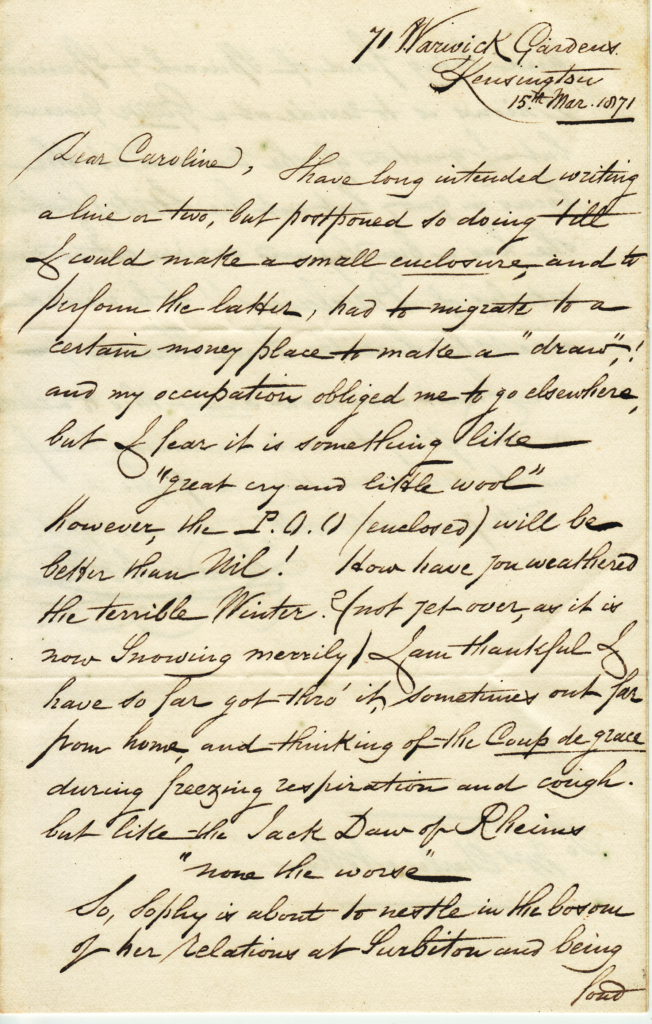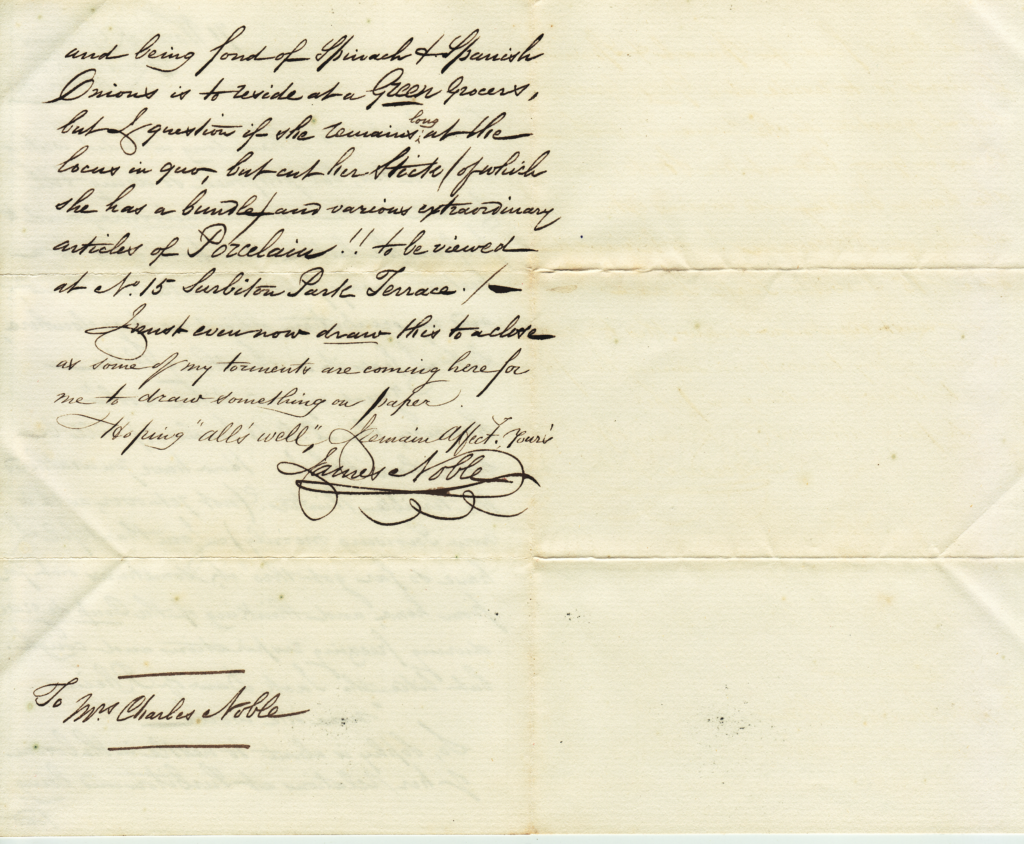A Kensington Architect’s Letter: James Noble to Caroline Noble, 15 March 1871 – James Noble letter to Caroline Noble 1871
The letter is written by James Noble (1795–1875), an architect of the London area, to his daughter-in-law Caroline Noble (née Glenister, b. 1831). The letter is dated 15 March 1871 and sent from “71 Warwick Gardens, Kensington.” It is light-hearted and informal, demonstrating both a sense of humour and the familial affection James held for Caroline.
In the letter, James apologises for not writing sooner and explains he had postponed sending a letter until he could enclose a small sum of money (likely a postal order or banknote). He humorously laments that the effort of making a financial “draw” was delayed by his professional obligations. He refers to the recent severe winter, wonders how Caroline and family have coped, and jokes about his own health, referencing the “coup de grâce during freezing respiration and cough,” but assures her he’s survived “none the worse,” likening himself to the “Jack Daw of Rheims” (a popular humorous poem by Thomas Ingoldsby).
James mentions “Sophy” (likely a family member or servant) moving to Surbiton to live with relatives, making a playful comment about her fondness for spinach and Spanish onions and her new residence being a “Green Grocer,” as well as her collection of porcelain. He closes abruptly as he is called away by his professional duties, referring to his colleagues or clients as “tormentors” and signing off with affection.
Correspondence from 71 Warwick Gardens, Kensington, to Caroline Noble (nee: Glenister) 15 March 1871 from her widowed father-in-law:
Historical Context
James Noble’s lifetime (1795–1875) spanned major periods in British history: the late Georgian era, the entire Victorian era up to the 1870s, and the dramatic urbanisation and industrialisation of London. As an architect, James would have witnessed—and perhaps contributed to—the rapid expansion of the city and the development of its grand new neighbourhoods like Kensington, where he wrote this letter.
Family Structure:
-
James Noble married Susanna Noble (1796–1841).
-
Their son, Charles Noble (1823–1887), continued the London connection and married Caroline Glenister (b. 1831), the recipient.
-
This kind of intergenerational letter, full of wit and everyday detail, is a prime example of 19th-century upper middle-class family correspondence.
Social Setting:
-
The address “Warwick Gardens, Kensington” places James firmly in a respectable, rising neighbourhood—Kensington was becoming fashionable for professionals and the burgeoning middle class.
-
The reference to Surbiton, at the time a growing commuter suburb, shows the family’s upward mobility and London’s changing urban landscape.
Everyday Life & Health:
-
The “terrible Winter” refers to a notably harsh season in Britain (the winter of 1870–71 was unusually cold).
-
Coughs, colds, and the threat of serious illness (especially in the elderly) were common anxieties, and the humor here is a way of both acknowledging and coping with real risk.
Humour and Literary Reference:
-
The “Jack Daw of Rheims” (from The Ingoldsby Legends) is a mischievous tale about a bird that survives misadventures—James is likening himself to a survivor.
-
The playful mention of “tormentors” for colleagues and the running joke about Sophy and the Green Grocer shows typical Victorian wit and a close family rapport.
Analysis
Tone & Intent
-
Affectionate and Witty: The letter is informal and affectionate, laced with self-deprecation and literary jokes. James writes to reassure, amuse, and maintain a close bond with Caroline.
-
Familial Support: Sending money, even a small amount, underscores the habit of older relatives supporting younger branches, especially during difficult seasons.
Genealogical & Social Value
-
This letter is a valuable insight into the character and daily life of James Noble late in life. It also demonstrates:
-
The literacy and education level of the family (easy literary allusions, fluent style).
-
A sense of responsibility and caring between generations.
-
The importance of humour and stoicism in Victorian correspondence, particularly regarding illness and adversity.
-
Material Culture
-
The reference to “porcelain” and “various extraordinary articles” is a nod to the Victorian love of collecting and displaying objects, another marker of the family’s social status and tastes.
Significance for Family History
-
This letter is a vivid personal snapshot, directly linking four generations (James → Charles → Caroline → their descendants) and rooting your family firmly in the heart of 19th-century London professional society.
-
It humanises your ancestors, giving them voices, personalities, and relationships beyond the dry facts of dates and places.


